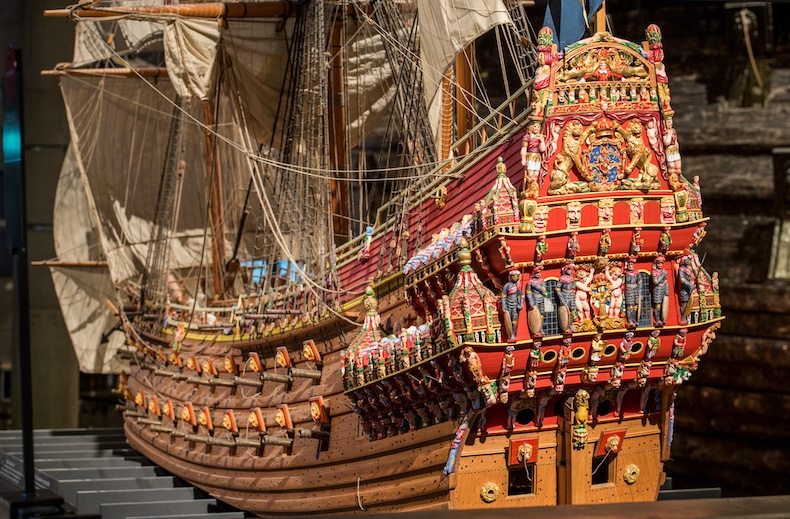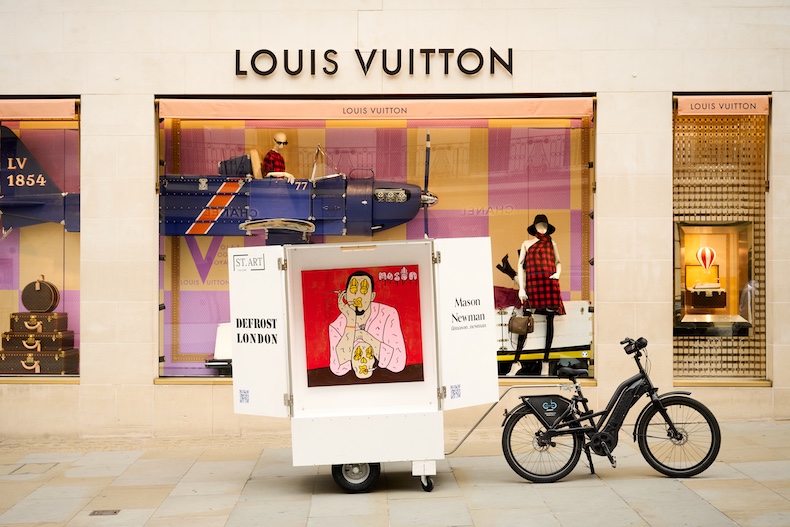As Rose DeWitt Bukater installs herself in her cabin on the RMS Titanic, her most urgent task is to hang not the heaps of dresses sitting in her trunks but the paintings she has brought aboard to enliven the transatlantic crossing. Enriched with canvases by Degas and Picasso, her suite is transformed in moments into one of the most sumptuous art galleries in the world.
The scene is from James Cameron’s reimagining of the Titanic’s maiden voyage, of course, but the seaborne museum is not merely a figment of fiction. In the Renaissance, the difference between galley and gallery was just one letter. The Real, the Spanish flagship at the Battle of Lepanto of 1571, went to war bristling with carvings, trophies and paintings designed by the Italian artist Giovanni Battista Castello. The heavy Falstaffian figures affixed to the hull of the Vasa, pride of King Gustavus Adolphus of Sweden’s navy, helped dispatch the vessel to the floor of Stockholm harbour a few minutes into its inaugural cruise in front of an audience of thousands.

In that era of demonstrative piety, even run-of-the-mill ships were sent into battle with richly painted altars, in the hope that prayer might achieve what cannon could not. Pictures did not only journey by sea, of course. For the wealthy traveller setting out on horseback, the portable altarpiece was no less important a part of the equipage than a compass, perfume and fresh breeches.
Indeed, as David Landau sets out in his recent book Art on the Move in Renaissance Italy, long before the coming of the international blockbuster show, art of all sorts was on the road every day. Monarchs and nobles progressed from one residence to another carrying tapestries and plates with them. Painters and sculptors crossed Europe touting their wares. Artefacts made precisely for convenience of transport – medals, coins, miniatures – were in perpetual motion. When Marcel Duchamp created La Boîte-en-valise – a kind of museum in a suitcase made up of travel-ready reproductions of his works – he was really just exploiting modern methods of manufacture to revivify ancient habits.
Mobile museums can take deceptive forms. The Victoria and Albert Museum might seem the opposite of Duchamp’s conceit: a hulk of red brick and Portland stone, it looks like it would not move a millimetre off its foundations in the wildest of earthquakes. Yet from the decade of its inception onwards, the V&A was on the move. A circulation department was set up with the task of disseminating items to galleries, art schools and technical colleges in the regions of the United Kingdom, where they might be utilised for the purposes of improvement. Exhibits were dispatched from London to all corners of the country in purpose-built vans that could be conveyed by road, rail or water. The American writer Moncure Conway recounted how, on a visit to the V&A in the late 19th century, he sought out a picture of the building. A vendor he approached in the hope of obtaining one sent him away empty-handed with the explanation: ‘The museum doesn’t stand still long enough to be photographed.’

With the development of the multi-campus museum, the international art fair and the global dealership, the mobilisation of art has been institutionalised. Works shuttle back and forth between Paris and Abu Dhabi, Basel and Miami with as little friction as iPhones or Nike trainers. The target audiences are not students or provincial artisans, as with the V&A’s circulating collection, but the jet set.
In recent years, however, some have sought to reclaim the mobile museum for the masses. In New York, two curators have repurposed a removal van to create the U-Haul Gallery, filling the interior with pictures. Their aim is to offer an ‘inclusive and accessible’ alternative to the conventional gallery, capable of taking exhibits directly to individuals in their own neighbourhoods rather than waiting for them to show up at the museum doors. A similar aspiration motivated the inventors of the ST.ART ‘Gallery Bike’ in London. Consisting of a fold-out trailer laden with artworks fixed to a bicycle, the bike can be used to mount exhibitions on almost any pavement in front of unsuspecting passers-by, giving a whole new meaning to street art.
Most ambitious of all, the French organisation Art Explora has launched a veritable fleet of mobile museums to bring exhibitions to communities where engagement with the arts is low. The inaugural visit to the United Kingdom by an Art Explora lorry took works by the likes of Turner, Constable and Hepworth from the Tate collection on a tour of Merseyside. Motor vehicles form the core of Art Explora’s pool of mobile museums, but the organisation has recently added a catamaran to its fleet. For the time being, the exhibitions on board are limited to multimedia productions, so in the unlikely event that the boat strikes an iceberg, there’s no danger of Les Demoiselles d’Avignon slipping beneath the waves.


